The power grid, or electrical grid, is a network of electricity transmission lines that distribute power between generation plants and utility companies, and from utility to utility. The power grid, sometimes referred to as simply “the grid” is an integral part of our daily lives, and many people have a little understanding of how it works and what it does to promote reliable electricity service. This article aims to outline each aspect of the electricity grid.
What Is A Power Grid?
Power grids in the U.S., and in the rest of the world for that matter, are essential to daily life. Without reliable electricity businesses cannot operate, trains can’t run, and people cannot heat or cool their homes. Power grids play a critical role in ensuring the safe and constant supply of electricity.
High-powered electrical transmission lines are connected directly to electrical power generation stations, such as nuclear power plants, coal power plants, natural gas electricity generation stations, solar fields, wind farms, and other types of electricity generators. At a very high voltage, the power is distributed throughout the country as these lines span states and territories to ensure that electricity can be delivered to each part of the country.
Along with electricity generation plants, the interconnected network of electrified transmission lines is also referred to as the electric grid. The grid plays an essential role in delivering electricity to local utility companies so that it can be used by both business and residential energy consumers.
How Does The Grid Work?
Each electrical grid is owned or operated by a system operator (more on the U.S. electricity grid below). And, the job of the system operator is to ensure that the demand for electricity and the supply of electricity is in constant balance.
Because electricity cannot be stored efficiently and must be used immediately as it is generated, blackouts can occur if there is not enough electricity to meet consumer demand. On the other hand, if there is too much electricity on the grid, it can cause transmission lines to overheat and become damaged.
In an effort to balance power supply and demand, most grid operators have a 24 hour scheduling and clearing process in which they dispatch power from electric generators, schedule power to be consumed by end users, and act as the wholesale electricity market, or market clearing mechanism between wholesale generators and retail buyers.
Electrical Grid Advances
With new technology comes many new electric grid advances. These advances are aimed at making the electricity grid more efficient, cost-effective, and ultimately more reliable. Let’s explore some of the latest power grid enhancements.
Microgrids
Microgrids are a fairly new phenomenon over the last decade or so. Microgrids act as a self-sufficient electricity system typically in a small and localized area. Microgrids are becoming popular in smaller communities, university settings, and even being used as backup sources of electricity generation in hospitals and data centers.
Although usually connected to the larger electric grid for backup, microgrids consist of their own sources of electricity generation like wind, hydro, and solar to power the small community which relies on them. As parts of the electric grid become older, microgrids offer a great advantage of electricity independence.
Distributed Energy
Similar to a microgrid, a distributed energy resource aims to add electricity generation to a single location. This aims to create electricity for a small group of localized consumers and to alleviate reliance on the larger power network. Today, solar and wind power are being used as distributed energy resources as well as battery storage.
Smart Grid Technology
President Biden signed the Bipartisan Infrastructure Law which funds the Grid Resilience Innovative Partnership (GRIP) program and the Transmission Facilitation Program. These programs aim to create a smarter electricity grid using technology and software. In fact, these programs provide incentives and financing for upgrading the electrical transmission network and for implementing technologies to make the grid more efficient and reliable. Some of these enhancements include:
- Increases in distributed energy resources to alleviate demand on the main electricity grids
- Implementation of software to predict real-time outages and automatic switches to reroute power on the grid
- Relays that can sense and automatically recover from electrical grid faults
This bill allows for $13 billion in financing for the modernization of the U.S. power grid.
The U.S. Power Grid
The U.S. power grid system is considered to be one of the most advanced electricity grids in the world. Although there is rhetoric around the age and reliability of the U.S. electric grid, it has set an example for the global electricity economy. The U.S. power grid is made up of three major interconnected transmission networks, or interconnections:
- the Eastern Interconnection
- the Western Interconnection
- the Texas Interconnection

Within these interconnections exist several regional transmission organizations (RTOs) and independent system operators (ISOs) that operate the regional electricity grid systems. The major grid operators include:
- ISO New England (ISO-NE)
- New York ISO (NY-ISO)
- PJM Interconnection (PJM)
- Midcontinent (MISO)
- Southwest Power Pool (SPP)
- ERCOT
- and California ISO (CAISO)

These system operators are responsible for ensuring that electricity supply and demand are in current balance by matching electricity generation with consumer usage. The grid operators are also responsible for creating and managing the wholesale electricity markets in each region.
Texas Electricity Fun Fact: As you can see from both illustrations above, Texas is on its own electrical grid. In fact, most of the state of Texas exists on the Texas Interconnection and is operated by ERCOT, the Texas power grid operator.
Want To Learn More About Electricity Grids?
Our team of wholesale and retail energy market experts has a deep understanding of electricity transmission, distribution, and how the electrical grid operates. In fact, some of our larger customers participate in the wholesale electricity markets by paying for power directly at cost from the grid operator. If you want to learn more about electricity grids and what they could mean for your business, contact our team today.



